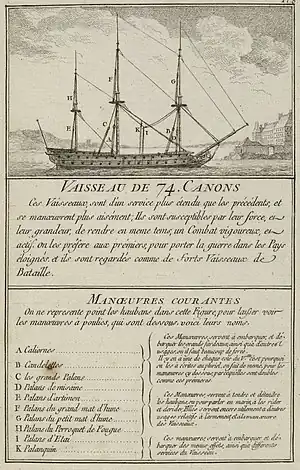French ship Palmier (1752)
Palmier was a 74-gun ship of the line of the French Navy.

History
Built by Joseph Véronique-Charles Chapelle, her keel was laid down at Brest on 14 November 1750 as part of the shipbuilding boom between the end of the War of the Austrian Succession in 1748 and the start of the Seven Years' War in 1755.[1] She was built to the norms set for ships of the line by French shipbuilders in the 1740s to try to match the cost, armament and manouvrability of their British counterparts, since the Royal Navy had had a greater number of ships than the French since the end of the wars of Louis XIV.[2]
She was launched on 21 July 1752 and completed in October of the same year. She was commanded by Joseph de Bauffremont during the Canadian campaign by Rémy-Claude de Bullion's fleet in May 1755 at the start of the Seven Years' War. She did not fight at Lagos or Quiberon Bay, in which the Toulon and Brest fleets were defeated in a new attempt at an invasion of Britain.
In June 1766 it was ordered that she should be rebuilt at Brest because her timbers were so rotten that it was not possible to save any for a refit. Taken in hand at Brest Dockyard, she was re-launched in December 1766 and emerged, essentially as a new ship to the lines of Citoyen, a new 74-gun designed by Joseph-Louis Ollivier.
In 1778 Palmier was under Boscal de Réals as part of the White-and-Blue squadron, the vanguard of the fleet under Orvilliers. She took part in the Battle of Ushant on 27 July 1778.[3][4][5]
In 1780 she was sent to the Antilles as part of de Guichen's fleet. There she fought in the Battle of Martinique on 16 April and in two other indecisive encounters against Rodney's forces. In May 1781 she served as François-Aymar de Monteil's flagship in the Franco-Spanish attack on Pensacola in Florida. The Palmier then joined de Grasse's fleet, which had just arrived from France, and returned with it to the Antilles.
On 12 September 1781 she was in the midst of the battle of Chesapeake, a decisive French victory which lead to the British defeat in the Siege of Yorktown. Still stationed in the Antilles, she took part in the Battle of St Kitts in January 1782. On 12 April she was part of the rearguard at the French defeat in the Battle of the Saintes. She was retired from the fleet the same year when it was ordered back to France, but was sunk by a major storm off the Bermudas on 24 October 1782.[6]
Citations
- Patrick Villiers, La France sur mer : De Louis XIII à Napoléon Ier, Paris, Fayard, coll. « Pluriel », 2015, 286 p. (ISBN 978-2-8185-0437-6), page 126
- Martine Acerra and André Zysberg, L’essor des marines de guerre européennes : 1680–1790, Paris, éditions SEDES, coll. « Regards sur l'histoire », 1997, 298 p. (ISBN 2-7181-9515-0), pages 90–91
- Troude (1867), p. 7.
- Lacour-Gayet (1905), p. 615-617.
- Chack (2001), p. 379.
- Contenson (1934), p. 221.
References
- Chack, Paul (2001). Marins à bataille (in French). Vol. 1. Paris: Le Gerfaut. ISBN 9782901196921. OCLC 552986998.
- Contenson, Ludovic (1934). La Société des Cincinnati de France et la guerre d'Amérique (1778-1783). Paris: éditions Auguste Picard. OCLC 7842336.
- Vergé-Franceschi, Michel (2002). Dictionnaire d'Histoire maritime. Paris: Robert Laffont. ISBN 2-221-08751-8.
- Lacour-Gayet, Georges (1910) [1902]. La Marine militaire de la France sous le règne de Louis XV (in French) (revue et augmentée ed.). Honoré Champion éditeur. OCLC 238796968.
- Lacour-Gayet, Georges (1905). La marine militaire de la France sous le règne de Louis XVI. Paris: Honoré Champion. OCLC 763372623.
- Meyer, Jean; Acerra, Martine (2017). Histoire de la marine française. Rennes: éditions Ouest-France. ISBN 9782737311291. OCLC 243817054.
- Roche, Jean-Michel (2005). Dictionnaire des bâtiments de la flotte de guerre française de Colbert à nos jours. Vol. 1. Group Retozel-Maury Millau. ISBN 978-2-9525917-0-6. OCLC 165892922. (1671-1870)
- Troude, Onésime-Joachim (1867). Batailles navales de la France (in French). Vol. 2. Challamel ainé. OCLC 836362484.
- Winfield, Rif; Roberts, Stephen S (2017). French Warships in the Age of Sail 1626–1786: Design Construction, Careers and Fates. Seaforth. ISBN 978-1-4738-9351-1.